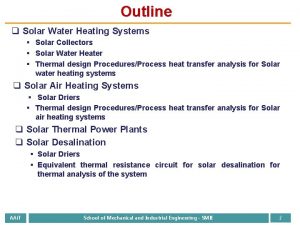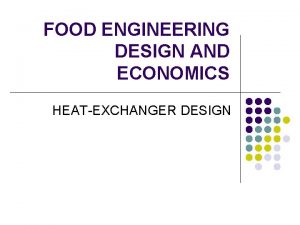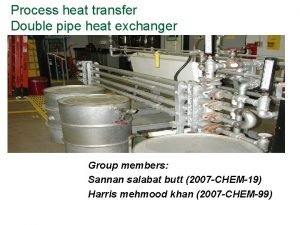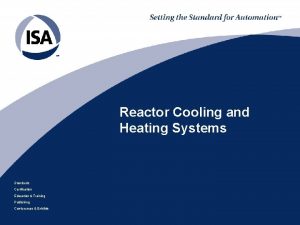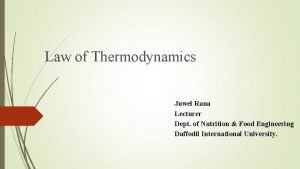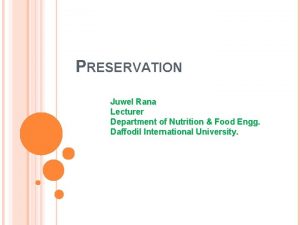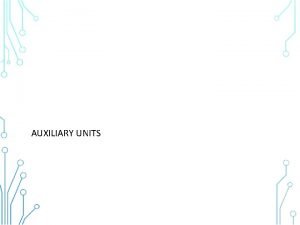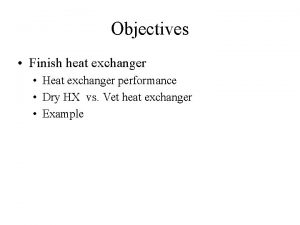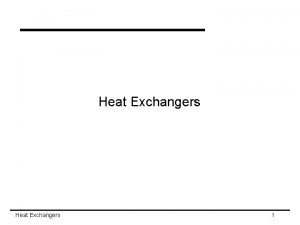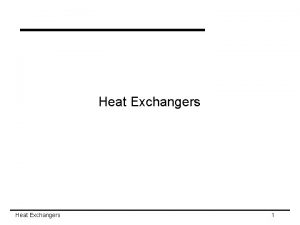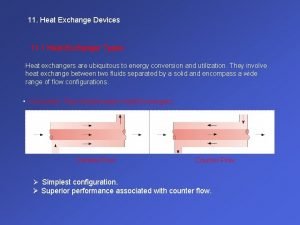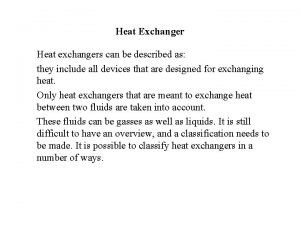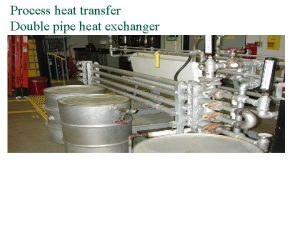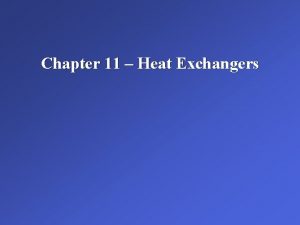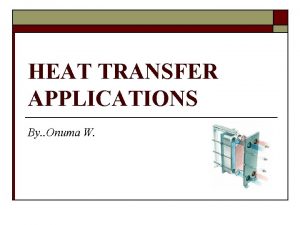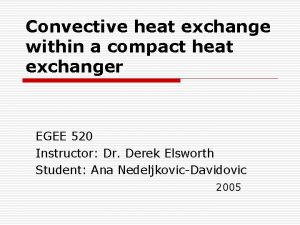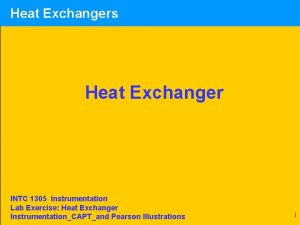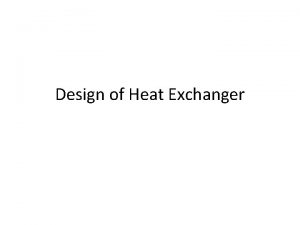HEAT EXCHANGER Juwel Rana Lecturer Dept of Nutrition

























- Slides: 25

HEAT EXCHANGER Juwel Rana Lecturer Dept. of Nutrition & Food Engineering Daffodil International University

Heat will transfer higher to lower Temperature. During winter season, We feel much comfortable. Our hand has lower temperature than cup.

Home Scale Milk Boiling Industrial Scale Milk Boiling/Pasteurization

IN INDUSTRY, WHICH EQUIPMENT'S ARE USING FOR PASTEURIZATION/ BOILING/ COOKING? Heat Exchanger

HEAT EXCHANGERS : HEAT EXCHANGERS is a equipment which is used in food industry. Heat energy is transferred from one body or fluid stream to another by heat exchanger. The equipment goes under many names, such as boilers, pasteurizers, jacketed pans, freezers, air heaters, cookers, ovens and so on

CLASSIFICATION OF HEAT EXCHANGER

PLATE HEAT EXCHANGER

PLATE HEAT EXCHANGER Hot Fluid In/ Steam/Hot water Pasteurized Milk/ Juice Hot Fluid Loses its Temperature Cold Fluid In/ Milk/ Juice

PLATE HEAT EXCHANGER

PLATE HEAT EXCHANGER: This heat exchanger consists of a series of parallel, closely spaced stainless-steel plates pressed in a frame. Channels are formed between each plate. The product and heat transfer medium flow through alternate channels. Because of the narrow channel between the plates, the fluid flows at high velocities and in a thin layer resulting in very high heat transfer rates per unit heat transfer surface area. It is mostly used for heating fluids to temperatures below the boiling point of water at atmospheric pressure. Plate heat exchangers are now used in virtually anywhere tubular heat exchangers were previously used.

PLATE HEAT EXCHANGER: (CONT) The direction of the product stream versus the heating/cooling stream can be either parallel flow (same direction) or counter flow (opposite direction) to each other. The plates used in the plate heat exchanger are constructed from stainless steel. Plate heat exchangers are suitable for low-viscosity ( 5 Pas) liquid foods. In industrial-size plate heat exchangers, product flow rates from 5000 to 20, 000 kg/h often are obtained. This type of heat exchanger was developed for the dairy industry.

PLATE HEAT EXCHANGERS OFFER THE FOLLOWING ADVANTAGES: The maintenance of these heat exchangers is simple, and they can be easily and quickly dismantled for product surface inspection. The plate heat exchangers have a sanitary design for food applications. Their capacity can easily be increased by adding more plates to the frame. With plate heat exchangers, we can heat or cool product to within 1°C of the adjacent media temperature, with less capital investment than other noncontact-type heat exchangers. Plate heat exchangers offer opportunities for energy conservation by regeneration.

TUBULAR HEAT EXCHANGER

TUBULAR HEAT EXCHANGER

TUBULAR HEAT EXCHANGER The simplest noncontact-type heat exchanger is a double-pipe heat exchanger is known as tubular heat exchanger. In tubular heat exchanger consisting of a pipe located concentrically inside another pipe. The two fluid streams flow in the annular space and in the inner pipe, respectively. The product flows through the inside tube, while the heating medium (usually water) flows through the outer jacket, either in the same direction (called concurrent flow) or in the opposite direction (called countercurrent flow). Probably the most important factor to keep in mind when describing heat transfer in this type of heat exchanger is that the log mean temperature difference.

HEAT EXCHANGER ACCORDING TO FLOW

PLATE HEAT EXCHANGER (COUNTER FLOW) Hot Fluid In/ Steam/Hot water Pasteurized Milk/ Juice Hot Fluid Loses its Temperature Cold Fluid In/ Milk/ Juice

FIND OUT THE EQUATION OF LMTD Parallel flow. Counter flow.

PARALLEL FLOW

COUNTER FLOW

PROBLEMS A heat exchanger in which the two fluids can flow in the same direction through the equipment. In this heat exchanger hot fluids entering into at 100 C and discharge at 78 C and liquid raw milk entering at 25 C and discharge at 72 C. What would be LMTD.

PLATE HEAT EXCHANGER (COUNTER FLOW) Hot Fluid In/ Steam/Hot water 100 c Pasteurized Milk 72 C Hot Fluid Loses its Temperature 78 C Cold Fluid In/ Milk 25 C

A heat exchanger in which the two fluids can flow in the opposite direction through the equipment. In this heat exchanger hot fluids entering into at 100 C and discharge at 78 C and liquid raw milk entering at 25 C and discharge at 72 C. What would be LMTD.

PROBLEMS:

PROBLEMS: EXAMPLE 6. 1. Cooling of milk in a pipe heat exchanger. Milk is flowing into a pipe cooler and passes through a tube of 2. 5 cm internal diameter at a rate of 0. 4 kg/s. Its initial temperature is 49°C and it is wished to cool it to 18°C using a stirred bath of constant 10°C water round the pipe. What length of pipe would be required? Assume an overall coefficient of heat transfer from the bath to the milk of 900 Jm-2 s-1 °C-1, and that the specific heat of milk is 3890 J/kg °C and rate of heat transfer 1580 J/s.
 Lecturer's name or lecturer name
Lecturer's name or lecturer name Gcwak
Gcwak Physician associate lecturer
Physician associate lecturer Lector vs lecturer
Lector vs lecturer Lecturer in charge
Lecturer in charge Lecturer name
Lecturer name Spe distinguished lecturer
Spe distinguished lecturer Lecturer in charge
Lecturer in charge Designation lecturer
Designation lecturer Pearson lecturer resources
Pearson lecturer resources Good afternoon teacher and my friend
Good afternoon teacher and my friend Lecturer asad ali
Lecturer asad ali Cfa lecturer handbook
Cfa lecturer handbook Designation of lecturer
Designation of lecturer 140000/120
140000/120 Photography lecturer
Photography lecturer Extended surface heat exchanger
Extended surface heat exchanger Law of heat exchange
Law of heat exchange Daikin outdoor thermistor
Daikin outdoor thermistor Solar hot water heat exchanger
Solar hot water heat exchanger Heat exchanger
Heat exchanger Pipe in pipe heat exchanger
Pipe in pipe heat exchanger Dsqr certification
Dsqr certification Plate type exchanger
Plate type exchanger Grid diagram heat exchanger network
Grid diagram heat exchanger network Triple pipe heat exchanger
Triple pipe heat exchanger



















